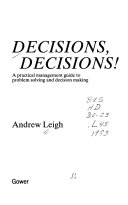

Effective decision-making is crucial in both personal and professional contexts. The book emphasizes the need for structured decision-making frameworks that help individuals and organizations navigate complex choices. By utilizing models such as the OODA loop (Observe, Orient, Decide, Act), readers learn to analyze situations more effectively, assess risks, and make informed decisions. These frameworks provide clarity and help in prioritizing options, ultimately leading to better outcomes. The author illustrates this concept with real-world examples, showcasing how businesses that adopt a systematic approach to decision-making can outperform their competitors.
Continue readingOne of the key discussions in 'Decisions, Decisions!' revolves around the cognitive biases that affect our judgment. The book outlines various biases, such as confirmation bias, anchoring, and overconfidence, explaining how they can lead to poor decision-making. By understanding these biases, readers can develop strategies to mitigate their effects, such as seeking diverse perspectives, questioning assumptions, and using data-driven approaches. The author provides practical exercises to help individuals recognize their biases and make more objective decisions. This section is particularly valuable for leaders and managers who must navigate complex environments where biases can cloud judgment.
Continue readingEmotions play a significant role in how we make decisions, and the book delves into this psychological aspect. While traditional decision-making models emphasize rationality, the author argues that emotions can provide valuable insights and should not be ignored. The book discusses the concept of emotional intelligence and how it can enhance decision-making capabilities. By learning to balance emotions with rational thought, individuals can improve their ability to make sound decisions. The author shares stories of leaders who have successfully integrated emotional awareness into their decision-making processes, highlighting the benefits of this approach.
Continue readingIn today's digital age, data plays a crucial role in decision-making. The book emphasizes the importance of data-driven approaches, encouraging readers to leverage analytics and metrics to inform their choices. The author discusses various tools and techniques for gathering and analyzing data, as well as the importance of interpreting data correctly. By adopting a data-driven mindset, individuals and organizations can reduce uncertainty and make more informed decisions. The book also addresses the challenges of data overload and provides strategies for filtering and focusing on the most relevant information.
Continue readingCollaboration is essential in many decision-making scenarios, especially in teams and organizations. The book highlights the benefits of collaborative decision-making, where diverse perspectives are considered, leading to more innovative solutions. The author discusses techniques for fostering collaboration, such as brainstorming sessions, consensus-building exercises, and structured dialogues. Additionally, the book addresses potential pitfalls of groupthink and how to avoid them. By promoting a culture of collaboration, organizations can enhance their decision-making processes and create a more inclusive environment.
Continue readingTechnology has transformed the way we make decisions, and the book explores this impact in depth. From artificial intelligence to machine learning, the author discusses how these technologies can assist in decision-making by providing insights and automating processes. However, the book also warns against over-reliance on technology, emphasizing the need for human judgment and intuition. The author encourages readers to find a balance between leveraging technology and maintaining a critical thinking approach. This section is particularly relevant for professionals in tech-driven industries who must navigate the complexities of modern decision-making.
Continue readingThe final key idea revolves around the concept of continuous improvement in decision-making. The book advocates for a growth mindset, where individuals learn from their decisions—both successes and failures. The author introduces the idea of 'decision audits,' where individuals reflect on past decisions to identify what worked, what didn’t, and why. This practice fosters a culture of learning and adaptability, essential traits in today's fast-paced world. By embracing continuous improvement, readers can enhance their decision-making skills over time, leading to better outcomes in both personal and professional contexts.
Continue reading